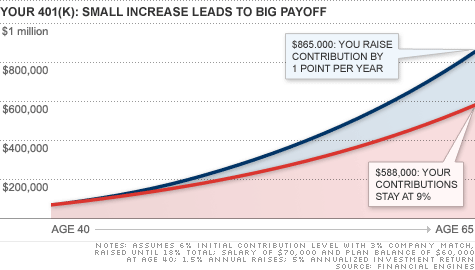Search News

(Money Magazine) -- As the bull market peaked in 2007, the typical 401(k) participant had 73% of his portfolio in stocks -- an aggressive stake that probably had more to do with inattention than market outlook.
"A very common mistake is that once people enroll in their 401(k), inertia sets in," says Francis Kinniry, a principal in Vanguard's Investment Strategy Group. In fact, only 17% of all 401(k) participants rebalanced last year, reports Aon Hewitt.
What's more, even though automatic 401(k) enrollment is getting more workers to save, enrollees have been slow to budge from the typical 3% initial contribution rate. In a recent survey of 401(k) investors by BlackRock, 85% said they should save 10% to 12% of pay, yet only half managed to set aside that much.
You're also letting inertia take hold when you fail to question what you own.
Ross Levin recently decided to sell his clients' stakes in Fairholme Fund, a member of the MONEY 70. Performance wasn't the problem -- the fund has returned an annualized 11.1% over the past 10 years, vs. 2.8% for the S&P 500.
Rather, Levin is concerned that manager Bruce Berkowitz, who takes big positions in just a few stocks, can't be as nimble now that assets have topped $20 billion. "I am constantly selling what my clients love as part of our process of reassessing every decision," says Levin. Are you as ruthless? 'My biggest money mistake'
Forgone savings: The downside of saving too little is self-evident. What may not be as apparent is that a very small shift can have a profound long-term effect.
Consider the impact of nudging up your 401(k) contribution rate just one percentage point a year: As the graphic at right shows, a 40-year-old worker who's already saving 9% of pay can boost her balance at retirement by nearly 50% through a gradual ratcheting up in savings, according to the retirement advisory firm Financial Engines.
Lower returns: Regular rebalancing forces you to sell high and buy low. Colorado Springs financial planner Allan Roth calculates that a portfolio of 40% U.S. stocks, 20% international stocks, and 40% bonds rebalanced once a year would have returned an annualized 4.5% since the beginning of 2000; left alone, the same portfolio would have returned 3.7%. Since 2008, the rebalanced portfolio would have outperformed an untouched one by an annualized 2.8% to 1.6%.
Vulnerability to bursting bubbles: Through inertia, you can be lulled into thinking that anything that has delivered for you in the past will keep delivering. Bond funds attracted $315 billion in fresh cash during the height of the financial crisis. But with interest rates near historical lows, the inevitable rise in yields from here will mean price declines.
"After 30 years of falling interest rates, it's more than likely the bond funds you think are so safe could in fact be anything but safe," says Panaccione.
You're a creature of habit: When you keep investing in the same old, same old, you're falling victim to "inattention bias," according to Victor Ricciardi, an assistant professor of business at Goucher College.
Delayed gratification isn't in your DNA: Even if you're a good saver, your gut may be telling you that you can do better. But doing so would crimp your lifestyle. "Our natural bias is to consume today at the cost of not saving for tomorrow," says Ricciardi. You've got plenty of ways to spend your cash. Inertia makes it easy to think you're doing enough.
Put yourself on an annual maintenance calendar: When does your company announce raises? That's the day you increase your retirement plan contribution. What's your anniversary at work? That's the day you rebalance your entire portfolio.
Attach a face to your savings goal: Earmarking accounts can nearly double savings rates, recent research has found. "Labeling an account Henry's college fund or Jen's wedding account gives you a vivid purpose that can help you stay committed to your savings plan," says Hal Ersner-Hershfield, a visiting assistant professor at Northwestern University's Kellogg School of Management.
Put your portfolio on trial: Once a year, question whether you should still own all your investments -- winners and losers. For mutual funds, ask: Is the same manager in charge, are the assets way up or down, has the investment approach changed (check top holdings or the style box on morningstar.com), are expenses below average, and, if the fund has lagged, is there a valid reason, like the entire sector is off? Have a money question? Ask The Help Desk ![]()
| Overnight Avg Rate | Latest | Change | Last Week |
|---|---|---|---|
| 30 yr fixed | 3.80% | 3.88% | |
| 15 yr fixed | 3.20% | 3.23% | |
| 5/1 ARM | 3.84% | 3.88% | |
| 30 yr refi | 3.82% | 3.93% | |
| 15 yr refi | 3.20% | 3.23% |
Today's featured rates: